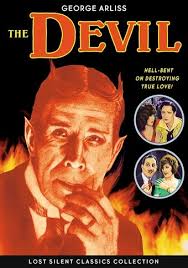
While visiting an artist friend of his, named Paul de Veaux (Edmund Lowe), Georges Roben (Roland Bottomley) tells his friend that he is engaged to Marie Matin (Lucy Cotton). Seeing his friend so happy and in love causes Paul to become depressed. He laments to his model and mistress Mimi (Sylvia Breamer) that love has passed him by.
Later George, Marie and Marie’s aunt (Florence Arliss) visit Paul at his studio. Paul gives the couple a painting that Marie admired as a present. Marie’s aunt sees Mimi in another room half dressed. The aunt doesn’t approve of the situation.
When Paul has an exhibition at a gallery Georges is unable to get away from work until later. He has Marie ask Paul to take her to the exhibit and says he will join them later. Marie is looking at a painting called “The Martyr- Truth Crucified by Evil”. She remarks to Paul that the painting is wrong. She says that evil can never overcome truth. A man nearby overhears what Marie says. He says he agrees with what his wife is saying. Paul remarks that Marie is not his wife.
When Georges arrives he is introduced as Marie’s fiancé. The man, Dr. Muller (George Arliss) admits thinking that Marie was Paul’s wife. Muller invites them all to his home on Sunday. Dr. Muller has something more insidious in mind than just an afternoon of listening to music. Having heard Marie’s talk about evil never overcoming truth he decides to play a little game.
Dr. Muller is in reality the devil and loves playing games with humans. He decides that he will destroy Georges and Marie’s relationship by creating jealousy and distrust between the two lovers using Paul and Mimi as pawns.
“The Devil” was released in 1921 and was directed by James Young. It is a silent drama that is a film version of the 1908 play “The Devil” by Ferenc Molnar with George Arliss reprising his role as Dr. Muller the devil. At one time the film was thought to be lost until a print was discovered in the nineties by a Canadian named Larry Smith. He donated it to the Library of Congress. They have preserved the film. I believe they also restored the film but I don’t think they have released it to wide distribution. It is available via Alpha Video but the quality is whatever Alpha managed to get a hold of.
George Arliss was born Augustus George Andrews in 1868. He was an English actor, author, playwright, and filmmaker who performed In Britain but primarily in the United States. He was the first British actor to win an Academy Award. The award was for his performance as Victorian era British Prime Minister Benjamin Disraeli in “Disraeli” (1929). He was also the oldest actor to win the honor at the time. “The Devil” was Arliss’ first play and years later his first film.
During the silent film era many stage plays were converted to film as movies. Quite often they followed closely to the action of the original play. Converting plays to screenplays proved a little difficult in that there was quite often a lot of silent talking going on but the intertitles only explained part of the action. The rest of the time you were relegated to trying to read the actors lips to get the entire idea of what was going on in the film.
That being said the movie is still an interesting little gem for many reasons. Preserving George Arliss’ first film is one of them.

